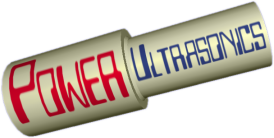Ultrasonic horns look simple. They're not.
Even the simplest small-diameter round sonotrode has been dimensioned to resonate at precisely the right frequency and provide a specified gain. To make something similar you need to follow the procedure detailed below. For larger horns, complex shapes and anything else out of the ordinary the same steps will become very difficult and you should seek expert advice.
1. Select a frequency
If you're making a sonotrode for an existing ultrasonic system you must match its frequency. If you're starting from scratch you will need to purchase equipment with a particular operating frequency. The lowest available frequency is usually 20kHz - this gives the largest components and highest available power, so is most versatile. Constraints on size may force you to go to a higher frequency.
2. Select a suitable material
Your application may dictate certain requirements, such as wear resistance. If so, these will be in addition to the common requirements for sonotrode materials: high fatigue resistance and low acoustic losses (meaning that they shouldn't absorb too much energy from the vibrations). High strength alloys of aluminium and titanium are ideal; many other materials might be used but at the risk of high power losses.
3. Calculate the wavelength
First calculate sound velocity in the chosen material. Then using the frequency selected at step 1 you can find the wavelength - the sonotrode calculator can help you with these simple calculations.
4. Calculate theoretical dimensions
For axial-mode sonotrodes of certain shapes, the length of the sonotrode should be half of the wavelength you calculated. This is generally true for straight rods and stepped sonotrodes, provided the step is in the middle of the length. There's also a correction factor (taking account of the inaccuracy of the plane-stress assumption implied in this calculation), but it can usually be ignored for sonotrodes that have a relatively small diameter compared to their length. Other shapes will have different lengths - in some cases standard formulae or tables may be available, otherwise finite element analysis will be necessary.
It is common to add a "tuning allowance" of a few mm - material which should be machined off during the tuning process (step 6).
5. Consider unwanted modes of vibration
So far we've only looked at the desired mode of vibration, and it's common to think of a sonotrode as having only this one resonance which may or may not be at the right frequency. But in reality this is just one of many modes of vibration which all sonotrodes have. For simple shapes ignoring the other "unwanted" modes may cause no problems but for complex shapes or larger diameters you are very likely to an unwanted resonance close to the operating frequency. This can be disasterous for the welding process, with amplitude at the sonotrode tip being unevenly distributed and / or in the wrong direction. Now finite element analysis becomes vital - by testing multiple possible designs in the computer problems can be identified and solutions (perhaps) found.
6. Manufacture prototype, tune and test
No matter how much analysis is done the ultimate test is to make the sonotrode and test it. Specialist test equipment is required - at least a horn analyser capable of driving the sonotrode over a range of frequencies and measuring its response. Tuning is the process of gradually removing material from the sonotrode until its measured resonant frequency is within tolerance on the target frequency - a tolerance of 1% or less is common. At this time the unwanted resonant frequencies can also be measured - anything too close to the operating frequency may require a complete redesign.
